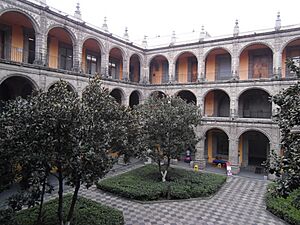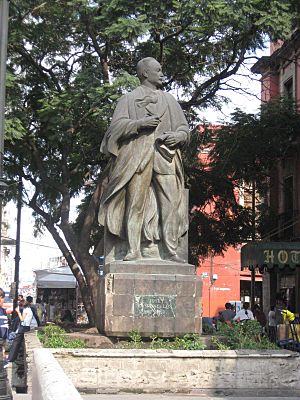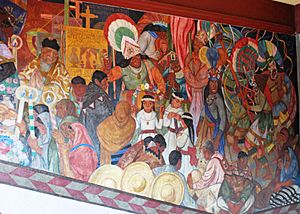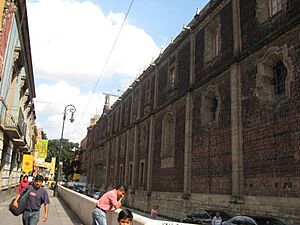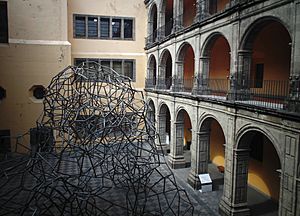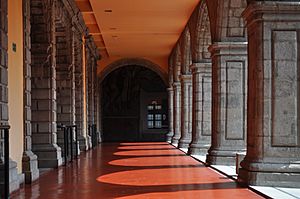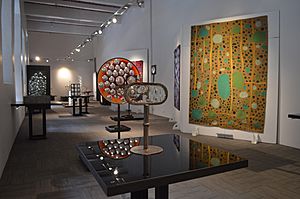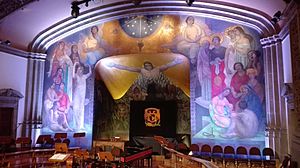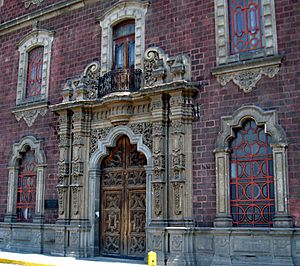Colegio de San Ildefonso, Mexico City facts for kids
| Colegio de San Idelfonso | |
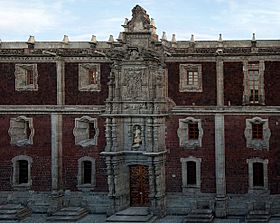
A colonial palace section façade: Colegio Grande
|
|
| Former name | San Ildefonso College Jesuit boarding school |
|---|---|
| Established | 1588 Jesuit boarding school |
| Dissolved | 1978 (became museum) |
| Location | San Ildefonso Street, Mexico City |
| Key holdings | José Clemente Orozco Diego Rivera |
| Birthplace of Mexican muralism | |
The Colegio de San Ildefonso is a famous building in Mexico City. Today, it is a museum and cultural center. It is known as the starting point for the important Mexican muralism art movement.
San Ildefonso began as a respected Jesuit boarding school. Later, it became the National Preparatory School. The school closed in 1978. Then, it reopened in 1992 as a museum and cultural center. The museum shows both old and new art, plus amazing murals painted by artists like José Clemente Orozco, Fernando Leal, and Diego Rivera. The building is in the historic center of Mexico City.
The college was founded in 1588. It has six main parts. Five parts are old colonial buildings, finished in 1749. These include the Colegio Grande, Colegio Chico, the chapel, El Generalito, and the courtyard of los Pasantes. The sixth part is the modern Bolívar Amphitheater, built in 1911.
History of San Ildefonso
From Jesuit School to Museum
The Jesuits arrived in Mexico in 1572. They started many schools for young people. San Ildefonso, founded in 1588, was one of their most important schools. In 1618, it joined with another college and received a special royal approval.
San Ildefonso was more like a boarding house and school. Young men lived and studied there. They also took classes at the Royal and Pontifical University of Mexico.
In the early 1700s, the school needed more space. Building work began in 1712 and finished in 1749. This new part is called "Colegio Chico" (Small College). The original part is "Colegio Grande" (Large College). The front of both parts, facing San Ildefonso Street, was built around this time.
The school was very important in the 1700s. But in 1767, the Jesuits were asked to leave all Spanish lands, including Mexico. The school was then run by other clergy. The building was also used for other things, like housing soldiers. During wars, American and French troops even used it as barracks.
Becoming a National School
By the 1860s, the old Jesuit school was in poor condition. In 1867, Benito Juárez reformed the education system. He made it a government responsibility, not controlled by the church. San Ildefonso became the National Preparatory School. Its first director, Gabino Barreda, organized the school with new ideas.
The school's goal was to prepare students for the new National University. The National University was re-established in 1910. The Preparatory School started with over 900 students. It became part of the university system in 1929. During student protests in 1968, the building was occupied by the army, causing damage to its old front door. The school closed completely in 1978.
Birthplace of Mexican Muralism
In the 1920s, after the Mexican Revolution, the government supported mural paintings. These murals showed Mexico's history and politics. San Ildefonso was one of the first public buildings to get these paintings. The Secretary of Education, José Vasconcelos, ordered the artwork.
Famous artists like Ramón Alva de la Canal, Fermin Revueltas, Fernando Leal, José Clemente Orozco, Diego Rivera, David Alfaro Siqueiros, and Jean Charlot painted murals here. Their work made San Ildefonso famous as the birthplace of Mexican muralism.
A Cultural Center Today
Today, San Ildefonso is a museum and cultural center. After closing in 1978, it reopened in 1992 for a special art show. In 1994, it became a permanent museum. It is run by the National Autonomous University of Mexico and other government groups.
The museum hosts temporary art and history exhibits. These shows focus on both Mexican and international cultures. It also helps to bring life back to Mexico City's historic center. The museum offers space for cultural events. There is also a gift shop with books, jewelry, and crafts.
Exploring San Ildefonso
The San Ildefonso Street Side
The long front of the building faces San Ildefonso Street. It is made of red volcanic stone called tezontle. Windows and doors are framed with grayish-white stone. The facade has two levels, with the lower one being larger. Most of this front belongs to the Colegio Grande, the original part of the college.
There are two large stone entrances. One leads to the Colegio Chico. This entrance is very old and has special designs. It features a relief showing Saint Ildephonsus. The other entrance leads to a smaller patio. It has reliefs of Saint Joseph and the Virgin of the Rosary.
Colegio Grande: The Main College
The Colegio Grande is the largest and oldest part of the complex. It has a big patio surrounded by arches, hallways, and rooms. There is also a smaller patio called "Patio de los Pasantes." The school part has three floors with a grand staircase. Most of the famous murals are here, painted by José Clemente Orozco between 1922 and 1927.
In the entrance area, there is a mural by Ramón Alva de la Canal. It shows "The Spanish Landing and Planting of the Cross." This fresco is considered one of the first modern Mexican history paintings. On the opposite wall is "Allegory of the Virgin of Guadalupe" by Fermin Revueltas.
On the second floor of the Colegio Grande, Orozco's murals include "The Old Order" and "The Trench." "The Trench" is considered one of his best works. On the third floor, you can see Orozco's "New Ideals" series.
The main staircase also has Orozco's mural "The Origin of Spanish America." Other artists painted on the upper part of the staircase. Jean Charlot's mural "The Conquest of Tenochtitlan" is on the southern wall. It shows Aztec history and uses metal pieces in the artwork. On the northern wall is "The Festivities of the Lord of Chalma" by Fernando Leal. This work is known for its bright colors.
The Chapel and El Generalito
Next to the main hallway is the old chapel. This chapel was used as a library when it was a preparatory school. It has several paintings.
On the other side of the hallway is "El Generalito." This was the main assembly room for the Preparatory School. It got its nickname, "the little general," because it was small but used for all important meetings. It has beautifully carved wooden choir stalls from an old convent. These stalls were made in the late 1600s and moved here in 1890. The room also has a special carved chair for the professors.
Patio de los Pasantes
The smaller courtyard of the Colegio Grande is called the "Patio de los Pasantes." "Pasantes" were students who had finished all their classes but still needed to write their final papers. These students lived in this part of the building. This patio has arches on three sides, with one blank wall.
Colegio Chico and Bolívar Amphitheater
The Colegio Chico has changed a lot over time but is still standing. It has a simple staircase. The muralist Siqueiros painted parts of this stairwell from 1922 to 1924, but he never finished. Much of his work was lost later. Only "The Elements" on the ceiling remains complete.
The main entrance to the complex is now on Justo Sierra Street, through the Simón Bolívar Amphitheater. This amphitheater was built between 1906 and 1911. It was designed to look like the old Baroque style of the rest of the building.
The lobby leading from the Justo Sierra entrance has beautiful decorations. On the left, there is a fresco by Fernando Leal called "Epopeya bolivariana." It shows heroes who fought for independence in the Americas.
Inside the Bolívar Amphitheater, you can see one of Diego Rivera's first murals, "The Creation." This mural shows many of Rivera's famous artistic styles. Other paintings here are by artists like Emilio Garcia Cahera and Ernesto García Cabral.
See also
 In Spanish: Antiguo Colegio de San Ildefonso para niños
In Spanish: Antiguo Colegio de San Ildefonso para niños
- List of colonial non-religious buildings in Mexico City
- List of Jesuit sites
Images for kids


